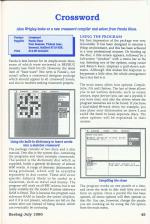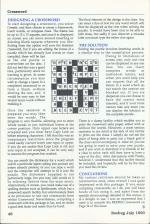
Beebug
 1st July 1990
1st July 1990
Categories: Review: Software
Author: Alan Wrigley
Publisher: Pandasoft
Machine: BBC Model B
Published in Beebug Volume 9 Number 3
Alan Wrigley looks at a new crossword compiler and solver from Panda Discs
Crossword (Panda Discs)
Panda is best known for its Ample music discs, some of which were reviewed in Beebug recently (see Vol. 8 No. 10). However, the latest item of "bear-ware" (the term is Panda's, not mine!) offers a crossword designer package which should appeal to all crossword lovers, and also to teachers seeking classroom projects.
The package consists of two discs and a slim manual. One disc is the system disc, containing the programs and some example crosswords. The second is the dictionary disc which as supplied, holds a general dictionary of almost 6000 words. A range of thematic dictionaries is being produced, which will be available separately in due course. These will cover specific subjects likely to be useful in a classroom, such as travel and money. The program will work on all BBC micros, but is not really suitable for the model B unless sideways RAM is fitted. This is because the program uses sideways RAM to handle the screen displays, and if it is not present, windows are left on the screen after use instead of being closed, which can eventually be confusing.
Using The Program
My first impression of the package was very favourable. It has been designed to emulate a Wimp environment, and this has been achieved in a very professional manner. On booting up the disc, a title screen appears, followed by a full-screen "window" with a menu bar at the top. Selecting any of the options, using cursor and Return keys, displays a pull-down sub-menu. Although this makes the response to keypresses a little slow, the whole arrangement has a nice feel to it.
The main menu offers four options: Compile, Solve, File and Options. The last of these allows you to set various defaults, such as screen colours, input device (you can use a joystick if you have one), and also the drives where the program resources are to be found. If you have a dual-sided 80-track drive, for example, you may place your dictionaries on drive 2 and avoid the need to keep separate discs. The other options will be explained in their context.
The program works on one puzzle at a time, and saves the work to disc each time you exit from an option. Once a puzzle file has been opened, all menu options will then operate on that file. You can, however, change the puzzle you are working on by using the File option from the main menu.
Designing A Crossword
To start designing a crossword, you select Compile, and then choose to create a framework, insert words, or compose clues. The frame can be up to 15 x 15 squares, and once it is displayed on screen you can move around inserting or deleting blank squares wherever you like.
Exiting from the option will save the skeleton crossword, but if you are editing the frame of a puzzle which has already had words or clues compiled, these will be lost as the old puzzle is overwritten on the disc. I did not feel this was a good idea, particularly since no warning is given. In some circumstances you may wish to change a space in a completed crossword to or from a blank without altering the rest, and it would be very easy to lose several hours' work without realising it.
Once the skeleton is prepared you may then enter the words. The program is very flexible, allowing you to enter whole words or just individual letters at the cursor position. Only upper case letters are accepted and you must have Caps Lock on before entering characters. I felt that this was an unnecessary restriction, since the program could easily convert lower case input to upper. If you do not realise that Caps Lock is off, and your input is not accepted, it can be very easy to assume the program has crashed.
You can search the dictionary for a word which will fit a particular space, taking into account any letters already present, or you can type a word and the computer will attempt to fit it into the puzzle. The dictionary supplied is not particularly large, but you may add words to it by selecting Options from the main menu.
Alternatively, of course, you could make use of a spelling checker such as Spellmaster, which has a crossword search facility, but unfortunately there is no provision to use star commands from within Crossword. Nevertheless, compiling a crossword with this package is fun, and no doubt a good deal faster and easier than by hand.
The final element of the design is the clues. You can enter a line of text for any word which will then be displayed as the clue when solving the puzzle. It would have been nice to be able to edit clues, but sadly if you discover a mistake later you must type the entire clue again.
The Solution
Solving the puzzle involves inserting words in a similar way to the compilation process.
Owing to limitations of screen size, only one clue can be displayed at any one time. You can insert complete words or individual letters, and when you need help you can request that all the letters in a word which do not match the answer are blanked out. If you are desperate you can choose to have the correct word inserted, and if your brain cannot take any more you can display the solution to the complete puzzle.
There is a dump facility which enables you to print the crossword onto paper, either with or without the words. However, a most serious omission to my mind is the lack of any facility to print out the clues. I simply do not see the point of being able to print out a blank grid if the clues cannot accompany it. After all, you are not going to want to solve your own puzzle, and if you wish to distribute it to friends or for a class to solve, each will then have to have a copy of the disc. After discussions with Panda, however, I understand that this facility should be included, and hopefully will be by the time you read this review.
Conclusions
My various criticisms should be taken as constructive ones, since overall I was quite impressed with this package. If you enjoy compiling crosswords, as I do, you will have hours of fun using it, and apart from the specific shortcomings detailed in this review, it is a delight to use. I was so impressed that I used it to compile the Beebug crossword on Page 54 of this issue.
This article was converted to a web page from the following pages of Beebug Volume 9 Number 3.
Scores
BBC Model B Version| Overall | 78% |



